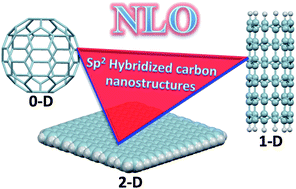Nonlinear optical (NLO) materials are the smartest materials of the era, and have the ability to generate new electromagnetic fields with changed frequencies, phases, and other physical properties. Recently, many cutting edge research reports have been focused on NLO materials especially on those which are composed of sp2 hybridized carbon nanostructures. As the carbon nanostructures are composed of abundant π-electrons and have significant delocalization, these are potential candidates for modern NLO materials. Generally, sp2 hybridized carbon nanostructures can be divided into zero-dimensional fullerenes, one-dimensional nanotubes and two-dimensional graphene nanoribbons and quantum dots etc. These dimensionally different carbon nanomaterials are promising candidates for a wide range of applications in next-generation nanotechnologies. In present feature article, we first briefly explain a theoretical structure–NLO property relationship based on perturbation theory and then elucidate the crucial factors to control the NLO responses. We put together the different random investigations of sp2 hybridized carbon nanostructures for NLO application by highlighting the importance of their several structural designs to tune NLO amplitudes. Furthermore, we make a comparative and updated analysis of the NLO properties of dimensionally different sp2 hybridized carbon nanomaterials i.e. fullerenes, carbon nanotubes, and graphene nanoribbons and quantum dots. Finally, we make a brief discussion about different aspects and opportunities to use the sp2 hybridized carbon nanomaterials as high performance NLO materials of the future. This review is a focused perspective based on different updated quantum chemical investigations about fullerenes, nanotubes and graphene nanoribbons and quantum dots for their possible use in nonlinear optical applications.

You have access to this article
 Please wait while we load your content...
Something went wrong. Try again?
Please wait while we load your content...
Something went wrong. Try again?


 Please wait while we load your content...
Please wait while we load your content...